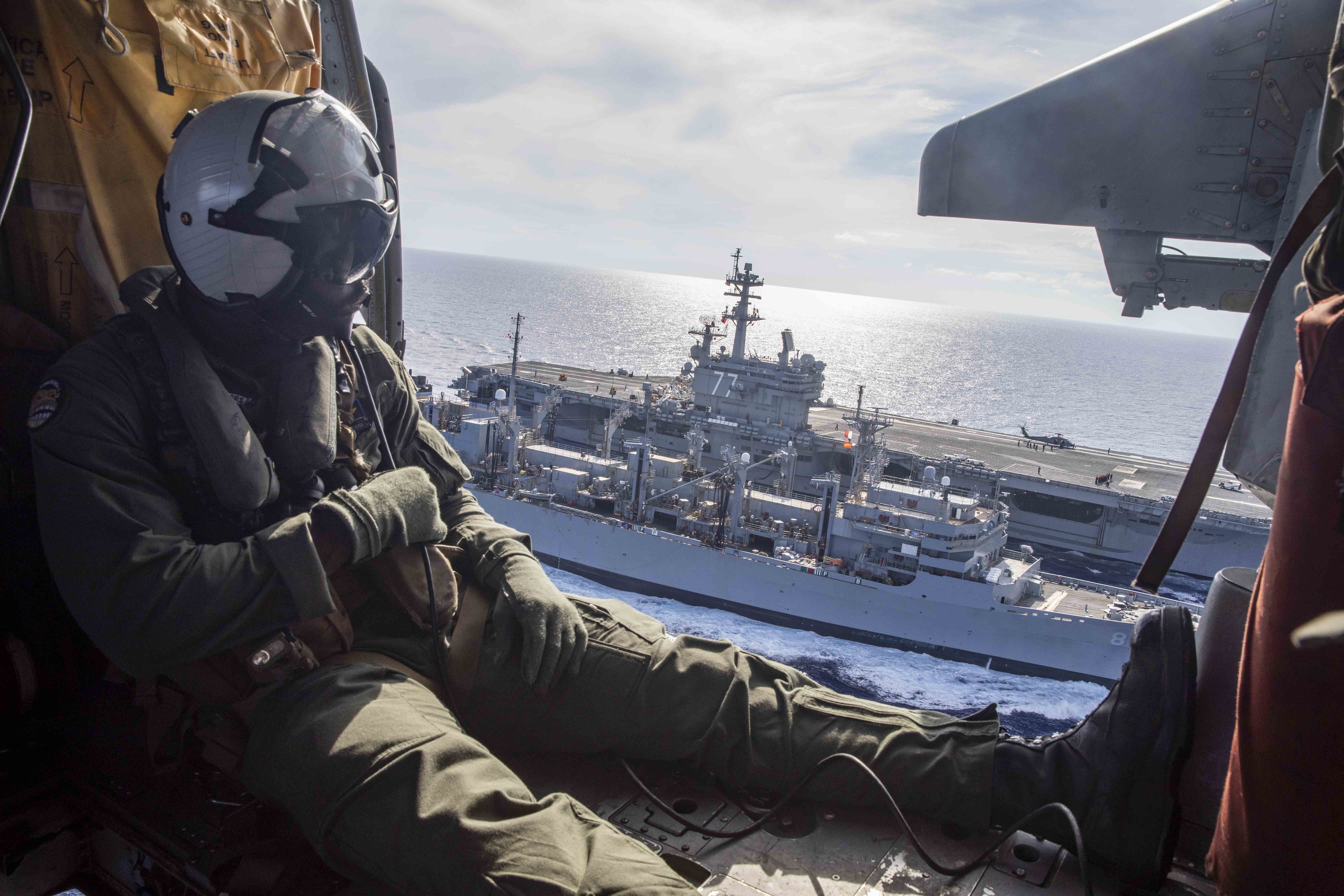
Naval Aircrewman (Helicopter) 3rd Class Taquan West, assigned to Helicopter Sea Combat Squadron (HSC) 5, keeps watch over the Nimitz-class aircraft carrier USS George H.W. Bush (CVN-77) and the fast combat support ship USNS Arctic (T-AOE-8) on June 28, 2022. US Navy Photo
The George H.W. Bush carrier strike group has completed its pre-deployment graduation exercise ahead of a deployment to U.S. European Command, USNI News has learned.
USS George H.W. Bush (CVN-77) and the embarked Carrier Strike Group 10 returned to Naval Station Norfolk, Va., last week following a more than month-long composite training unit exercise (COMPTUEX) in the Atlantic, according to U.S. 2nd Fleet.
“COMPTUEX lasts several weeks, during which units are tested on their proficiency and readiness for deployment through scenario-based, live training, that increases in complexity and intensity,” according to a statement from 2nd Fleet.
Part of the drills included the transfer of authority from U.S. 2nd Fleet to the Naval Striking and Support Forces NATO (STRIKFORNATO) out of Portugal. The Harry S. Truman carrier strike group, currently operating in the Mediterranean Sea, has come under NATO control twice during its deployment.
During the transfer of control, “the strike group used NATO reporting procedures, messaging formats and chat capabilities, reinforcing command and control and aligning communications channels to ensure a seamless process in the event of a crisis,” according to the release.
“In addition to the U.S. Navy participants, the 26th Marine Expeditionary Unit from Camp Lejeune, North Carolina, the Italian destroyer ITS Caio Duilio (D 554) and submarines from Brazil and Colombia joined the strike group.”
Bush will be embarked with Carrier Air Wing 7 along with guided-missile cruiser USS Leyte Gulf (CG-55), the staff of Destroyer Squadron 26, guided-missile destroyers USS Nitze (DDG-94), USS Truxtun (DDG-103) homeported in Norfolk, Va., and USS Farragut (DDG-99) and USS Delbert D. Black (DDG-119) homeported in Mayport, Fla.
CVW-7 includes:
- The “Pukin’ Dogs” of VFA-143 Strike Fighter Squadron (VFA) flying F/A-18Es from Naval Air Station Oceana, Va.
- The “Jolly Rogers” of VFA-103 – F/A-18F – from Naval Air Station Oceana.
- The “Sidewinders” of VFA-86 – F/A-18E – from Naval Air Station Lemoore, Calif.
- The “Knighthawks” of VFA-136 – F/A-18E – from Naval Air Station Lemoore.
- The “Patriots” of VAQ-140 – EA-18G – Electronic Attack Squadron (VAQ) – from Naval Air Station Whidbey Island, Wash.
- The “Bluetails” of VAW-121 – E-2D – Carrier Airborne Early Warning Squadron (VAW) – from Naval Air Station Norfolk, Va.
- The “Rawhides” of VRC-40 – Detachment – C-2A – Fleet Logistics Support Squadron (VRC) – from Naval Air Station Norfolk.
- The “Nightdippers” of HSC-5 – MH-60S – Helicopter Sea Combat Squadron (HSC) – from Naval Air Station Norfolk.
- The “Grandmasters” of HSM-46 – MH-60R – Helicopter Maritime Strike Squadron (HSM) – from Naval Air Station Jacksonville, Fla.
Bush, CVW-7 and its escorts are now expected to relieve USS Harry S. Truman (CVN-75) and CVW-1 that have been operating in the Mediterranean Sea since December. Aircraft from Truman have been key to U.S. presence operations along NATO’s eastern front flying 60 to 90 daily sorties, USNI News learned on a visit to the carrier in March.
Truman was extended by Secretary of Defense Lloyd Austin to operate in the region until it could be relieved by Bush, a defense official confirmed to USNI News earlier this year.
